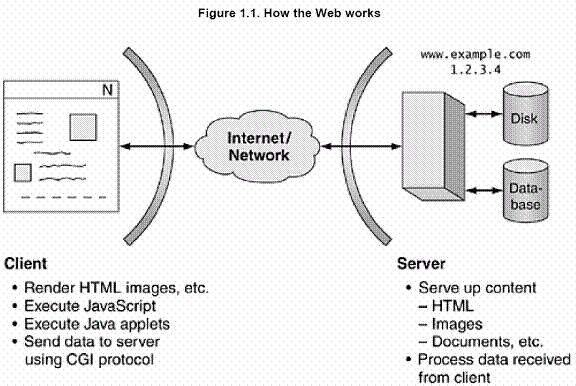How the Web Works
The Web is usually accessed through a browser, the most well known of which are Netscape/Mozilla and Internet Explorer. There are many alternative browsers, including Galeon, Konquerer, OmniWeb, and Opera, and also text-based options such as Lynx, links, and w3g.

When you click a link or type a URL into the location box (for instance, www.example.com), the browser makes a socket connection (also known as a network connection) to the server www.example.com. The name www.example.com maps to an Internet address, which is a number in the form 1.2.3.4—an IP, or dotted quad. The browser connects to www.example.com using port 80, the port that the server operating system opens for such HTTP requests. This port is standardized. Other ports are used for other Internet connections: 22 for SSH, 23 for Telnet, and so on.
Based on what the client requests, the server serves up, or delivers, information to the client. The type of data the server serves up includes plain text (this includes HTML), images, Java applets, various types of documents, PDFs, etc. This content that the server delivers can be generated by the server in one of several ways: static, dynamic, or embedded.
The client's job is to receive from the server a stream of text, images, Java applets, documents, and so on and render, or appropriately display, them. The client also executes any JavaScript code and Java applets that are served up. The client can send form data to the server using the Common Gateway Interface (CGI) protocol. The server can then process this data in whatever way it chooses. There are two sides to the processing that goes on: the client side and the server side. These two terms mean pretty much exactly what they seem to mean. The cool thing about this, as with many other things Web, is that once protocols are established, what happens on the client side or the server side is independent. If the client wants to block pop-up ads, there isn't much the server can do about it. If someone develops a new server-side application or improves an old one, the client doesn't care, as long as protocols are.
Next >> Serving Up |